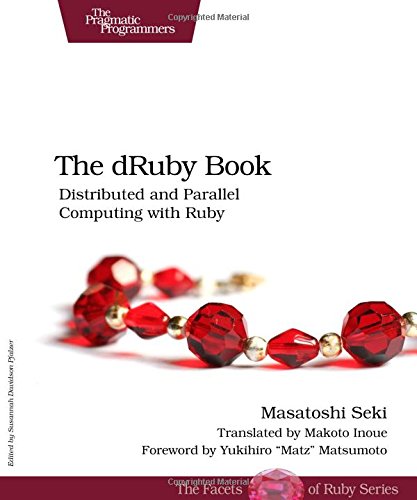

Most ebook files are in PDF format, so you can easily read them using various software such as Foxit Reader or directly on the Google Chrome browser.
Some ebook files are released by publishers in other formats such as .awz, .mobi, .epub, .fb2, etc. You may need to install specific software to read these formats on mobile/PC, such as Calibre.
Please read the tutorial at this link. https://ebooknice.com/page/post?id=faq
We offer FREE conversion to the popular formats you request; however, this may take some time. Therefore, right after payment, please email us, and we will try to provide the service as quickly as possible.
For some exceptional file formats or broken links (if any), please refrain from opening any disputes. Instead, email us first, and we will try to assist within a maximum of 6 hours.
EbookNice Team

Status:
Available0.0
0 reviews
ISBN 10: 193435693X
ISBN 13: 9781934356937
Author: Masatoshi Seki
Part I: Introducing dRuby
Hello, dRuby
1.1 Hello, World
1.2 Building the Reminder Application
1.3 Moving Ahead
Architectures of Distributed Systems
2.1 Understanding Distributed Object Systems
2.2 Design Principles of dRuby
2.3 dRuby in the Real World
2.4 Moving Ahead
Part II: Understanding dRuby
Integrating dRuby with eRuby
3.1 Generating Templates with ERB
3.2 Integrating WEBrick::CGI and ERB with dRuby
3.3 Putting Them Together
3.4 Adding an Error Page
3.5 Changing Process Allocation
3.6 Moving Ahead
Pass by Reference, Pass by Value
4.1 Passing Objects Among Processes
4.2 Passing by Reference Automatically
4.3 Handling Unknown Objects with DRbUnknown
4.4 Moving Ahead
Multithreading
5.1 dRuby and Multithreading
5.2 Understanding the Thread Class
5.3 Thread-Safe Communication Using Locking, Mutex, and MonitorMixin
5.4 Passing Objects via Queue
5.5 Moving Ahead
Part III: Process Coordination
Coordinating Processes Using Rinda
6.1 Introducing Linda and Rinda
6.2 How Rinda Works
6.3 Basic Distributed Data Structures
6.4 Toward Applications
6.5 Moving Ahead
Extending Rinda
7.1 Adding a Timeout in a Tuple
7.2 Adding Notifications for New Events
7.3 Expressing a Tuple with Hash
7.4 Removing Tuples Safely with TupleSpaceProxy
7.5 Finding a Service with Ring
7.6 Examples of Ring Applications
7.7 Moving Ahead
Parallel Computing and Persistence with Rinda
8.1 Computing in Parallel with rinda_eval
8.2 Concurrency in rinda_eval
8.3 Persisting a Tuple with PTupleSpace
8.4 Moving Ahead
Drip: A Stream-Based Storage System
9.1 Introducing Drip9.2 Drip Compared to Queue
9.3 Drip Compared to Hash
9.4 Browsing Data with Key
9.5 Design Goals of the API
9.6 Moving Ahead
Building a Simple Search System with Drip
10.1 Running the App
10.2 Examining Each Component
10.3 Crawling Interval and Synchronization with Indexer
10.4 Resetting Data
10.5 Using RBTree for Range Search
10.6 Adding a Web UI
10.7 Moving Ahead
Part IV: Running dRuby and Rinda in a Production Environment
Handling Garbage Collection
11.1 Dealing with GC
11.2 Using DRbIdConv to Prevent GC
11.3 Moving Ahead
Security in dRuby
12.1 dRuby’s Attitude Toward Security
12.2 Accessing Remote Services via SSH Port Forwarding
12.3 Summary
ruby the k-9
the fourth ruby
ruby and the booker brothers
the z-distribution table
the book x
the ruby way
the ruby rule
Tags: Masatoshi Seki, dRuby, Book